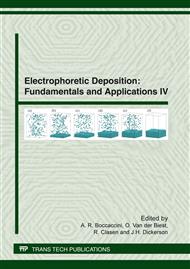p.21
p.27
p.35
p.41
p.47
p.53
p.61
p.67
p.73
Direct Numerical Simulations of Electrophoretic Deposition of Charged Colloidal Suspensions
Abstract:
Motivated by applications in the field of nanomanufacturing, we perform large-scale numerical simulations of the electrophoretic deposition of suspensions of charged colloids in an electrolyte. A simulation method is developed to model the full deposition process that captures linear electrophoresis, dipolar interactions, van-der-Waals forces, steric interactions, Brownian motion, as well as electric and hydrodynamic interactions with the electrodes. Using a fast algorithm, suspensions of up to 5,000 particles are simulated, and results are reported for the final deposit microstructure as a function of field strength. The simulation results demonstrate that regular crystalline colloidal assemblies are obtained at low field strengths and volume fractions, while more random structures with frequent defects are formed in stronger fields and at higher volume fractions, in agreement with recent deposition experiments.
Info:
Periodical:
Pages:
47-51
Citation:
Online since:
March 2012
Authors:
Price:
Сopyright:
© 2012 Trans Tech Publications Ltd. All Rights Reserved
Share:
Citation:


